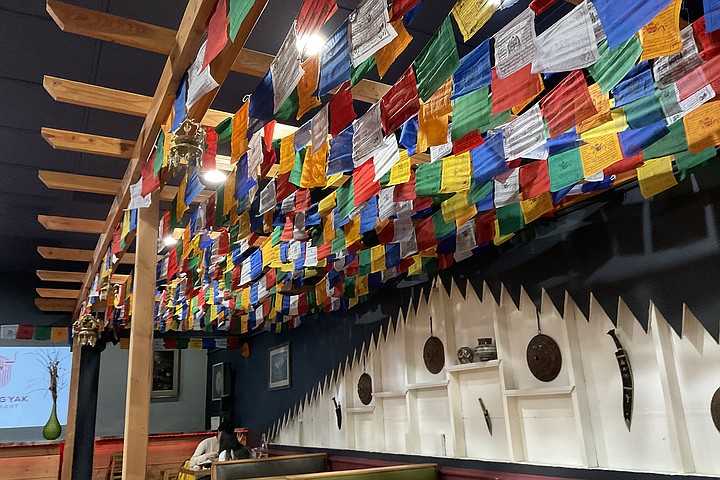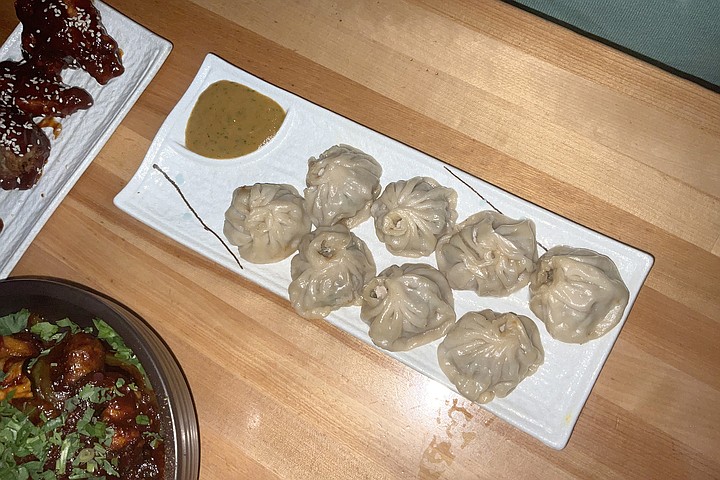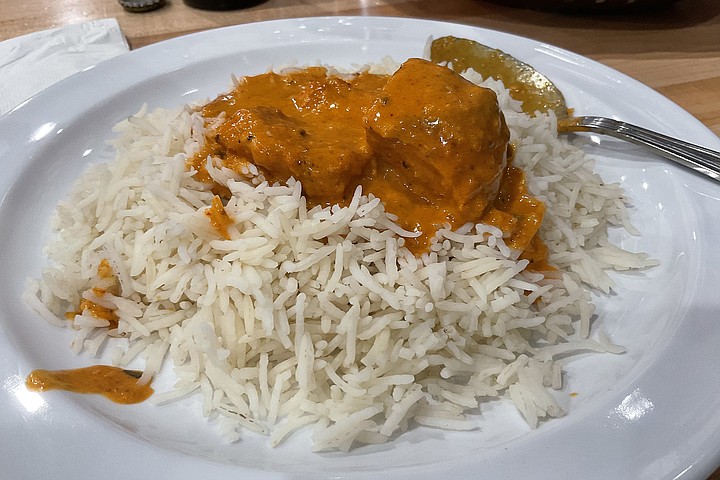 Facebook
Facebook
 X
X
 Instagram
Instagram
 TikTok
TikTok
 Youtube
Youtube

I came for yak, the classic mountain meat from the Himalayas. I ended up with tikka masala, the classic Indian dish from, uh, Scotland? But I’m getting ahead of myself. It was the yak that brought me here, to this new Nepalese Indian eatery up in Little India near Miramar College. The place is quite modern. I like the visual patterns — like the pattern of white mountain peaks against the gray wall at the back. (And next to them, a riot of multicolored actual Tibetan prayer flags fluttering over a row of booths.)
I was first attracted because this place’s name, “The Dancing Yak,” is just so cool. I’ve always liked those slow, strong, long-haired beasts of burden — the ones with the wavy, dark or even orange hair that sways off their sides, back and forth, as they carry ginormous loads up and down narrow mountain passes. I’m eager to find out if I like them on a plate as much as I do in the wild: it turns out this place offers yak to eat. Feel bad for the yaks, if you like: they’re known to be smarter than cattle, calmer than bison. But I still can’t help wondering what they taste like. The word on yak meat is it’s fat-free, nutritious, healthy, soft and juicy. Taste? Well, that’s something I’ve got to experience for myself. At least once. It must be the most Himalayan of all dishes.

I check the menu, and yak is all over it, though not cheap: a small plate of yak chili is $16.99. Momo jhol is ground yak-stuffed dumplings drowned in soup ($19.99). I’m just deciding on the yak chili when this gal Kishu comes up and says they are out of all yak meat. “I’m not sure when we’ll get more. It comes from Colorado.”
Uh, oh. Also: not imported from the Himalayas? A little less romantic. So we’re back to hunting down something else that sounds properly Nepali. Actually, what is Nepali food?
Here’s what I know going in: it’s basically Indian food with a touch of Chinese. Makes sense, since Nepal straddles the mountains between the Indian and Chinese civilizations. Thing is, it’s way up high. Weather’s cold. Not so much grows. Here on the menu, we’re looking at basics like biryani, the classic celebration dish of India. Okay, okay, it probably started off in Iran. A kind of fried rice with some sort of meat or veggie, but famous for the seductive herbal scents it wafts forth, a kind of invitation to celebrate. Here, the chicken biryani costs $16.99; the goat, $18.99.

Probably the comfort food dish Nepalese people go to most is Dal Bhat Tarkari: rice with lentil soup and vegetable curry. It’s the go-to every-day dish everyone has at home. Then the big Chinese presence on the menu is in the momos from Tibet. These are dumplings, stuffed with ground meat. Here, eight steamed veggie momos cost $11.99, chicken are $12.99, and yes, yak are $18.99. Oh, and chow mein is the other popular Chinese-Nepalese dish in Kathmandu. The yak version costs $15.99.
The Indian family at the next table is having momos (“The chili momos are the best.”) and biryani (“This is the most popular dish in India.”) But I suddenly remember reading a news item the other day about how Ali Ahmed Aslam, the self-proclaimed creator of “the most popular dish in the U.K.” had just died at age 77. That most popular British dish? Chicken tikka masala. Story said it beats out any dish in Britain, including fish and chips, for popularity. Yes, it’s the cliche “Indian dish for people who don’t know Indian food.” But there was no such thing back in 1964. Ali Ahmed Aslam was a Pakistani chef who lived in Glasgow, Scotland. He wanted to please a bus driver customer at his Shish Mahal (“Castle of Glass”) restaurant. The bus driver complained that his chicken tikka — basically a boneless version of tandoori chicken — was too dry and too spicy. Couldn’t Chef Ali do something? Chef Ali could. He tipped the customer’s tandoori-grilled chicken pieces into a hot pan, added a can of tomato soup concentrate (plus some spices, sliced onions, and maybe some cream?), stirred, simmered, and slid the plate back to the bus driver. The bus driver ate, and then couldn’t stop talking to everybody about this creamy Indian dish that had been invented just for him. The word was out, just in time for the curry house boom of the 1970s. It was that creamy, spicy, garlicky, oniony, tomatoey thing that sold Ali’s dish to the western palate. Now it’s everywhere, from fast food outlets to airline menus.

Aah. Kishu brings out a nice frosty bottle of water, a bottle of Taj Mahal lager beer ($6.99), a fresh, hot tandoori-baked garlic cilantro naan (bread, deliciously crisp-skinned, light, and floppy, $3.99), plus a little saucepan of rice and a bright orange mini-bucketful of chicken tikka masala. Not specifically Nepali, and okay, not even totally Indian. Sort of Scottish! But an outreach of a dish, and one that’s rich and delish. Plus, it’s creamy, and oh man, slightly peppery too, with big honest chunks of tandoori chicken, drowned in the sauce Chef Ali threw together and gave to the world. Scrumbo! And the small bucket holds just enough of the stuff. I don’t care if it’s cliche; talk about umami! It hits the spot. I don’t even miss the idea of the yak that I’d come here to find. Actually, I’m half relieved about that. Can imagine it being a bit gamey.
But I’ll be returning — for more of this deliciosity. And yes, someday, I’ll be back for the yak.


I came for yak, the classic mountain meat from the Himalayas. I ended up with tikka masala, the classic Indian dish from, uh, Scotland? But I’m getting ahead of myself. It was the yak that brought me here, to this new Nepalese Indian eatery up in Little India near Miramar College. The place is quite modern. I like the visual patterns — like the pattern of white mountain peaks against the gray wall at the back. (And next to them, a riot of multicolored actual Tibetan prayer flags fluttering over a row of booths.)
I was first attracted because this place’s name, “The Dancing Yak,” is just so cool. I’ve always liked those slow, strong, long-haired beasts of burden — the ones with the wavy, dark or even orange hair that sways off their sides, back and forth, as they carry ginormous loads up and down narrow mountain passes. I’m eager to find out if I like them on a plate as much as I do in the wild: it turns out this place offers yak to eat. Feel bad for the yaks, if you like: they’re known to be smarter than cattle, calmer than bison. But I still can’t help wondering what they taste like. The word on yak meat is it’s fat-free, nutritious, healthy, soft and juicy. Taste? Well, that’s something I’ve got to experience for myself. At least once. It must be the most Himalayan of all dishes.

I check the menu, and yak is all over it, though not cheap: a small plate of yak chili is $16.99. Momo jhol is ground yak-stuffed dumplings drowned in soup ($19.99). I’m just deciding on the yak chili when this gal Kishu comes up and says they are out of all yak meat. “I’m not sure when we’ll get more. It comes from Colorado.”
Uh, oh. Also: not imported from the Himalayas? A little less romantic. So we’re back to hunting down something else that sounds properly Nepali. Actually, what is Nepali food?
Here’s what I know going in: it’s basically Indian food with a touch of Chinese. Makes sense, since Nepal straddles the mountains between the Indian and Chinese civilizations. Thing is, it’s way up high. Weather’s cold. Not so much grows. Here on the menu, we’re looking at basics like biryani, the classic celebration dish of India. Okay, okay, it probably started off in Iran. A kind of fried rice with some sort of meat or veggie, but famous for the seductive herbal scents it wafts forth, a kind of invitation to celebrate. Here, the chicken biryani costs $16.99; the goat, $18.99.

Probably the comfort food dish Nepalese people go to most is Dal Bhat Tarkari: rice with lentil soup and vegetable curry. It’s the go-to every-day dish everyone has at home. Then the big Chinese presence on the menu is in the momos from Tibet. These are dumplings, stuffed with ground meat. Here, eight steamed veggie momos cost $11.99, chicken are $12.99, and yes, yak are $18.99. Oh, and chow mein is the other popular Chinese-Nepalese dish in Kathmandu. The yak version costs $15.99.
The Indian family at the next table is having momos (“The chili momos are the best.”) and biryani (“This is the most popular dish in India.”) But I suddenly remember reading a news item the other day about how Ali Ahmed Aslam, the self-proclaimed creator of “the most popular dish in the U.K.” had just died at age 77. That most popular British dish? Chicken tikka masala. Story said it beats out any dish in Britain, including fish and chips, for popularity. Yes, it’s the cliche “Indian dish for people who don’t know Indian food.” But there was no such thing back in 1964. Ali Ahmed Aslam was a Pakistani chef who lived in Glasgow, Scotland. He wanted to please a bus driver customer at his Shish Mahal (“Castle of Glass”) restaurant. The bus driver complained that his chicken tikka — basically a boneless version of tandoori chicken — was too dry and too spicy. Couldn’t Chef Ali do something? Chef Ali could. He tipped the customer’s tandoori-grilled chicken pieces into a hot pan, added a can of tomato soup concentrate (plus some spices, sliced onions, and maybe some cream?), stirred, simmered, and slid the plate back to the bus driver. The bus driver ate, and then couldn’t stop talking to everybody about this creamy Indian dish that had been invented just for him. The word was out, just in time for the curry house boom of the 1970s. It was that creamy, spicy, garlicky, oniony, tomatoey thing that sold Ali’s dish to the western palate. Now it’s everywhere, from fast food outlets to airline menus.

Aah. Kishu brings out a nice frosty bottle of water, a bottle of Taj Mahal lager beer ($6.99), a fresh, hot tandoori-baked garlic cilantro naan (bread, deliciously crisp-skinned, light, and floppy, $3.99), plus a little saucepan of rice and a bright orange mini-bucketful of chicken tikka masala. Not specifically Nepali, and okay, not even totally Indian. Sort of Scottish! But an outreach of a dish, and one that’s rich and delish. Plus, it’s creamy, and oh man, slightly peppery too, with big honest chunks of tandoori chicken, drowned in the sauce Chef Ali threw together and gave to the world. Scrumbo! And the small bucket holds just enough of the stuff. I don’t care if it’s cliche; talk about umami! It hits the spot. I don’t even miss the idea of the yak that I’d come here to find. Actually, I’m half relieved about that. Can imagine it being a bit gamey.
But I’ll be returning — for more of this deliciosity. And yes, someday, I’ll be back for the yak.